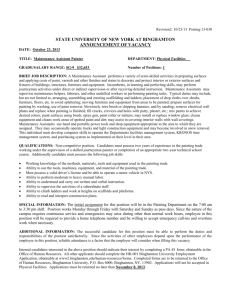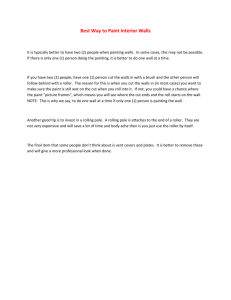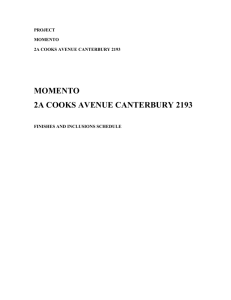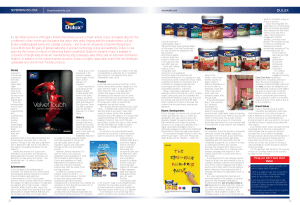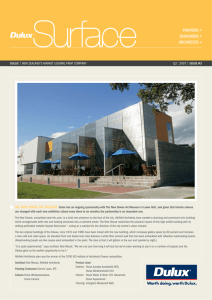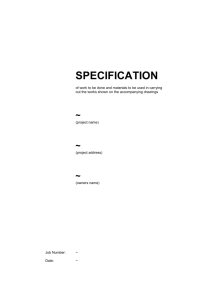6700d dulux painting general
advertisement
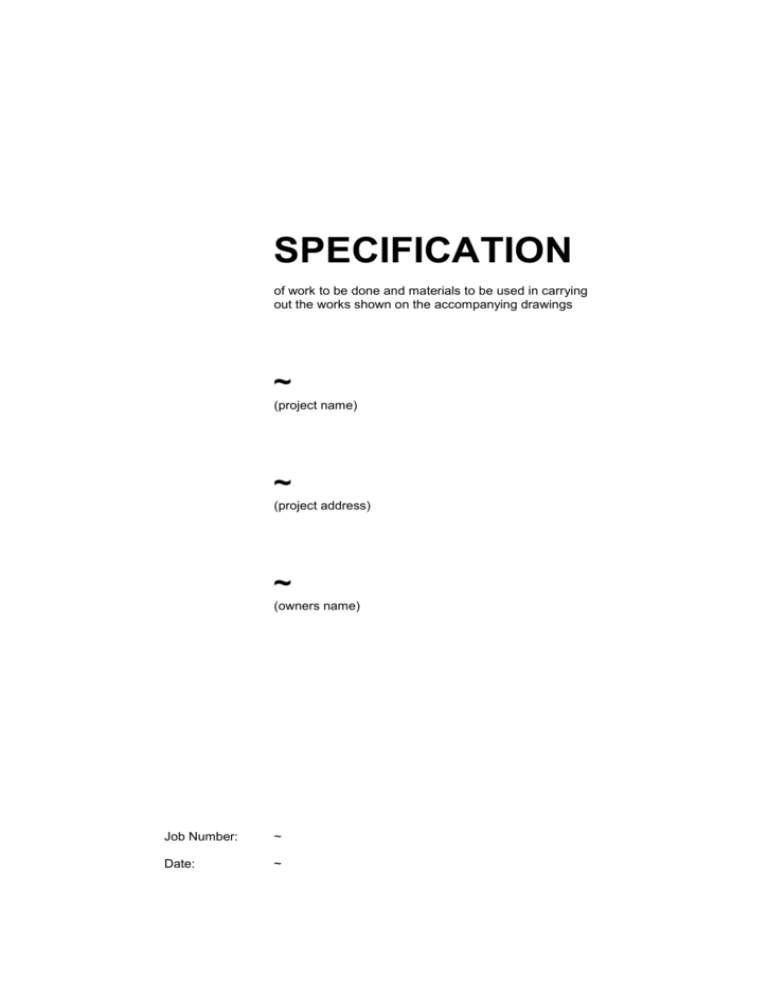
SPECIFICATION of work to be done and materials to be used in carrying out the works shown on the accompanying drawings ~ (project name) ~ (project address) ~ (owners name) Job Number: ~ Date: ~ 6700D DULUX PAINTING GENERAL 1. GENERAL This section relates to the general matters related to painting work. 1.1 RELATED WORK Refer to 6711D DULUX PAINTING EXTERIOR for exterior paint systems. Refer to 6721D DULUX PAINTING INTERIOR for interior paint systems. Refer to 6711DE DULUX ENVIRONMENTAL PAINTING EXTERIOR for environmental exterior paint systems. Refer to 6721DE DULUX ENVIRONMENTAL PAINTING INTERIOR for environmental interior paint systems. Refer to 6745D DULUX PROTECTIVE COATINGS for protective coatings or 6742DZ DULUX - ZONE INTUMESCENT COATINGS for intumescent coating systems. 1.2 ABBREVIATIONS The following abbreviations are used throughout this part of the specification: APAS Australian Paint Approval Scheme MPNZA Master Painters New Zealand Association Inc. VOC Volatile organic compound Documents 1.3 DOCUMENTS Refer to the general section 1233 REFERENCED DOCUMENTS. The following documents are specifically referred to in this section: AS/NZS 2311 Guide to the painting of buildings AS/NZS 2312 Guide to the protection of structural steel against exterior atmospheric corrosion by the use of protective coatings AS/NZS ISO 9001 Quality management systems - Requirements OSH Guidelines for the provision of facilities and general safety in the construction industry OSH Guidelines for the management of lead-based paint MPNZA Specification manual MPNZA Painters hazard handbook Health and Safety in Employment Act 1992 1.4 MANUFACTURER'S DOCUMENTS Manufacturer's and supplier's documents relating to work in this section are: Dulux DuSpec specification sheets and product data sheets Copies of relevant literature are available from Dulux Web: www.dulux.co.nz/specifier or www.duspec.co.nz Email: specifier@dulux.co.nz Telephone: 0800 800 424 Facsimile: 0800 801 424 Warranties 1.5 WARRANTY Warrant this work under normal environmental and use conditions against failure of materials and execution. Product warranty: Products must be applied in accordance with application and preparation procedures according to Dulux DuSpec Specifications and Product Data Sheets. Contact a Dulux Trade Representative for project specific warranties. Refer to the general section 1237WA WARRANTY AGREEMENT for the required format and details of when completed warranty must be submitted. Requirements © CIL Masterspec 2014 AUG 6700D DULUX PAINTING GENERAL Page 2 1.6 NO SUBSTITUTIONS Substitutions are not permitted to any specified Dulux system, or associated components and products. If in the applicator's own expertise and judgement an amendment to this specification is required, or where a substrate preparation or required painting system is not covered in this specification, this shall be brought to the attention of the contract administrator and any amendment agreed before work proceeds any further. 1.7 QUALIFICATIONS Painters to be members of MPNZA and experienced competent workers, familiar with the materials and the techniques specified. The applicator is to have the necessary skill, experience and equipment to undertake the work. The applicator remains responsible for ensuring proper completion of the work. 1.8 CONTROL SAMPLES Prepare samples of the finished work as scheduled, including preparation and colour as specified. Obtain written approval of the appearance before proceeding. Check colours to Dulux colour samples prior to application and keep the Dulux colour samples on site as a control reference. Refer to SELECTIONS for requirements. Use the Dulux Architectural Brushouts as a basis of standard where appropriate. Order brushouts online at www.dulux.co.nz/specifier/resources/a4-colour-samples or fax requests to Dulux NZ Customer Services on 0800 805 424. 1.9 HEALTH AND SAFETY Refer to the requirements of the Health and Safety in Employment Act and OSH: Guidelines for the provision of facilities and general safety in the construction industry. If the elimination or isolation of potential hazards is not possible then minimise hazards in this work on site by using the proper equipment and techniques as required in the MPNZA Painters hazard handbook. Supply protective clothing and equipment. Inform employees and others on site of the hazards and put in place procedures for dealing with emergencies. Refer to OSH: Guidelines for the management of lead-based paint for the required procedures and precautions when: - treating/removing lead-based paint - burning off paint - sanding off paint - using solvent based paint removers. 1.10 PRIOR TO WORK COMMENCING Before any work commences painters should verify with architect or specifying authority, that their paint matches a previously supplied standard card or panel. Differently coloured paints will vary in price, opacity and durability. Dulux normally only specify two coats of colour but with certain colours such as bold, brights and some corporate colours, three coats may be needed. 1.11 MATERIAL SAFETY DATA SHEETS Refer to Dulux for the material safety data sheets for every applicable product and comply with the safety procedures listed. Keep sheets on the site. Refer to www.dulux.co.nz/specifier. Performance 1.12 DULUX INSPECTION Permit representatives of Dulux to inspect the work in progress and take samples of their products from site if requested. © CIL Masterspec 2014 AUG 6700D DULUX PAINTING GENERAL Page 3 1.13 INSPECTION OF THE WORK Inspection of the whole of the work at each of the stages set out in SELECTIONS may be made. Agree a programme that will facilitate such inspection, including notification when each part and stage of the work is ready for inspection. 2. PRODUCTS Materials 2.1 PAINT TYPES Use the manufacturer's complete system and only the products specified. 2.2 MATERIALS GENERALLY Use only Dulux products which are guaranteed for their consistency and performance under AS/NZS ISO 9001 and APAS approval, prepared, mixed and applied as directed in the Dulux Duspec specification sheets, specification manuals and product data sheets. 2.3 THINNERS/ADDITIVES Use only if and when expressly directed by Dulux for their particular product in a particular application. Accessories 2.4 FILLERS For recommendations on; fillers, stopping, paint strippers, cleaning agents, etching solutions, mould inhibitors, rust inhibitors, knotting and other commodities used for the surface preparation, refer to the manufacturer of the specified preparation system. 2.5 GYPSUM FILLER - INTERIOR Finishing compound to match the plasterboard stopping system and finishing grade gypsum plaster to match the fibrous plaster system. For interior surfaces such as paper faced plasterboard use Dulux Professional Ultra 5 Surface Prep & Finish as an aid to achieving a Level 5 finish. 3. EXECUTION Conditions 3.1 EXECUTION To conform to manufacturer's requirements and those methods, practices and techniques contained in AS/NZS 2311, the MPNZA Specification manual, and OSH Guidelines for the provision of facilities and general safety in the construction industry. 3.2 PREPARE Prepare surfaces to Dulux's requirements. 3.3 COATED SURFACES Ensure that substrate surfaces are able to achieve the specified finish. 3.4 PRE-PRIMED SURFACES Sand down any breakdown or damage of the primer to a sound surface and immediately re-prime. 3.5 BRUSH DOWN Brush down surfaces immediately before application, to remove dust, dirt and loose material. 3.6 COMPATIBILITY Check that materials are as required by the paint manufacturers for the particular surface and conditions of exposure, and that they are compatible with each other. Use paint from the same manufacturer for each paint system. If not compatible, obtain instructions before proceeding. © CIL Masterspec 2014 AUG 6700D DULUX PAINTING GENERAL Page 4 3.7 TREATED SURFACES Where surfaces have been treated with preservatives or fire retardants, check with the treatment manufacturer that coating materials are compatible with the treatment and do not inhibit its performance. If they are not compatible, obtain instructions before proceeding. 3.8 ANCILLARY SURFACES The coatings listed in schedules and elsewhere are of necessity simplified. Coat ancillary exposed surfaces to match similar or adjacent materials or areas, except where a fairfaced natural finish is required or items are completely prefinished. In cases of doubt obtain instructions before proceeding. 3.9 LEAD-BASED PAINT, ASBESTOS Handle cautiously lead-based paint and asbestos, if present, as required in the MPNZA Painters hazard handbook and OSH Guidelines for the management of lead-based paint. 3.10 HARDWARE Do not paint hinges or hardware that cannot be removed. If items can be removed, carefully remove hardware, fixtures and fittings before commencing work. Set aside where they cannot be damaged or misplaced and replace on completion. 3.11 PROTECTION Use dropsheets, coverings and masking necessary to protect adjoining fixtures, fittings and spaces from paint drops, spots, spray and damage. Preparation 3.12 PREPARATION Refer to the DuSpec specification sheets for detailed substrate preparation notes relating to SELECTIONS contained in: - 6711D DULUX PAINTING EXTERIOR, 6721D DULUX PAINTING INTERIOR, 6711DE DULUX ENVIRONMENTAL PAINTING EXTERIOR and 6721DE DULUX ENVIRONMENTAL PAINTING INTERIOR. - www.duspec.co.nz. Application - before applying final coatings 3.13 OFF-SITE WORK Carry out off-site preparation and coating under cover, in a suitable environment and with adequate lighting. Store items both before and after coating in a clean, dry area, protected from the weather and mechanical damage, properly stacked and spaced to permit air circulation and to prevent sticking of surfaces. 3.14 PRIMING JOINERY Before priming preservative treated timber ensure that any cut surfaces have been retreated. Liberally coat end grain, allow to soak in and then recoat. Ensure LOSP. treated joinery has dried sufficiently to lose odour. 3.15 CONCEALED JOINERY SURFACES Apply off-site coatings to all surfaces including those which will be concealed when incorporated into the building. 3.16 CONCEALED METAL SURFACES Apply primer to suit the coating system to all metal surfaces which will be concealed when incorporated into the building. 3.17 DOORS Prime or seal and paint all six faces of doors before hanging. 3.18 BEAD GLAZING Before glazing apply the first two coats, or the primer and one undercoat, to rebates of stained, varnished or painted joinery and beads. © CIL Masterspec 2014 AUG 6700D DULUX PAINTING GENERAL Page 5 3.19 PUTTY FRONTING According to the putty manufacturer's instructions allow putty to set, then prime with an appropriate Dulux primer, either Dulux1 Step Acrylic Primer Sealer & Undercoat or 1 Step Oil Based Primer, Sealer & Undercoat. Fully protect the putty by completing the Dulux coating system as soon as it is sufficiently firm. Application - generally 3.20 PAINTING GENERALLY Comply with the Dulux Duspec specification sheets, product data sheets and the additional requirements of this work section. 3.21 MIXING Thoroughly mix paints. Lift any settled pigment and ensure the paint is homogenous. 3.22 ENVIRONMENT Paint exterior surfaces only in favourable weather conditions: - warm dry days without frost or heavy dews - avoid painting in direct sunlight any surfaces that absorb heat excessively - as far as possible apply paint in the temperature range 15°C to 25°C - do not paint if temperatures fall outside the range of 10°C and 35°C unless paints with the necessary temperature tolerance have been specified - do not apply solvent borne paint if moisture is present on the surface 3.23 SEQUENCE OF OPERATIONS Painting work to generally the following sequence: - Complete surface preparation before commencing painting - Apply primers, sealers, stains, undercoats, paints and clear coatings in the sequences laid down by Dulux - Allow the full drying times between coats laid down by Dulux - Do not expose primers, sealers and undercoats beyond a few days before applying the next coat - Finish broad areas before painting trim - Ensure batch numbers of tins are matched for whole areas - Internally paint ceilings before walls and walls before joinery, trim and other items. 3.24 PAINT APPLICATIONS Select brush, roller, or pad and apply paint to the requirements of Dulux and to obtain a smooth even coating of correct thickness, uniform gloss and colour. 3.25 DRYING TIME Before handling or applying the next coat of paint, give each coat the full drying time as required by the paint manufacturer. Ensure that surfaces are dry and that condensation does not occur before the paint reaches surface-dry condition. 3.26 LIGHTLY SAND Lightly sand primers, sealers, undercoats and intermediate coats to remove dust pick-up, protruding fibres and coarse particles. Remove dust immediately before applying the next coat. 3.27 DEFECTIVE WORK Correct defective work immediately and re-coat as required, following precisely the Dulux paint system specified. 3.28 EACH COAT Each coat of paint and the completed paint system to have the following qualities and properties: - uniform finish, colour, texture, sheen and hiding power - the specified number of coats applied - no blemishes such as runs, sags, crinkling, fat edges, entrained paint skins, hairs, dust, bare or starved patches, cracks, brush marks, ladder marks and blistering - proper covering of corners, crannies, thin edges, cracks, end grain and other difficult places of application © CIL Masterspec 2014 AUG 6700D DULUX PAINTING GENERAL Page 6 Completion 3.29 CLEAN Clean adjoining surfaces, glass and fittings of any paint contamination. Clean off glass indicators at completion of the building works. Clean glass inside and out to a shining finish. 3.30 CLEAN EQUIPMENT Use Dulux EnviroWash system for the cleaning of water-based paint and plasters from brushes, rollers, plastering or spray equipment to separate the solids from the water component for safe disposal. Phone 0800 800 424 for information regarding this system. 3.31 LEAVE Leave the whole of this work uniform in gloss and colour, of correct thickness, free from painting defects, clean and unmarked and to the standard required by following procedures. 3.32 REMOVE Remove dropsheets, coverings and masking to leave surrounding surfaces and areas clean, tidy and undamaged. Remove debris, unused materials and elements from the site. 3.33 REPLACE HARDWARE Replace hardware without damage to it or the adjoining surface. Leave properly fitted and in working order. 4. SELECTIONS Substitutions are not permitted to the following, unless stated otherwise. 4.1 SELECTIONS Refer to 6711D DULUX PAINTING EXTERIOR and 6721D DULUX PAINTING INTERIOR for selections. Refer to 6711DE DULUX ENVIRONMENTAL PAINTING EXTERIOR and 6721DE DULUX ENVIRONMENTAL PAINTING INTERIOR for selections. © CIL Masterspec 2014 AUG 6700D DULUX PAINTING GENERAL Page 7



